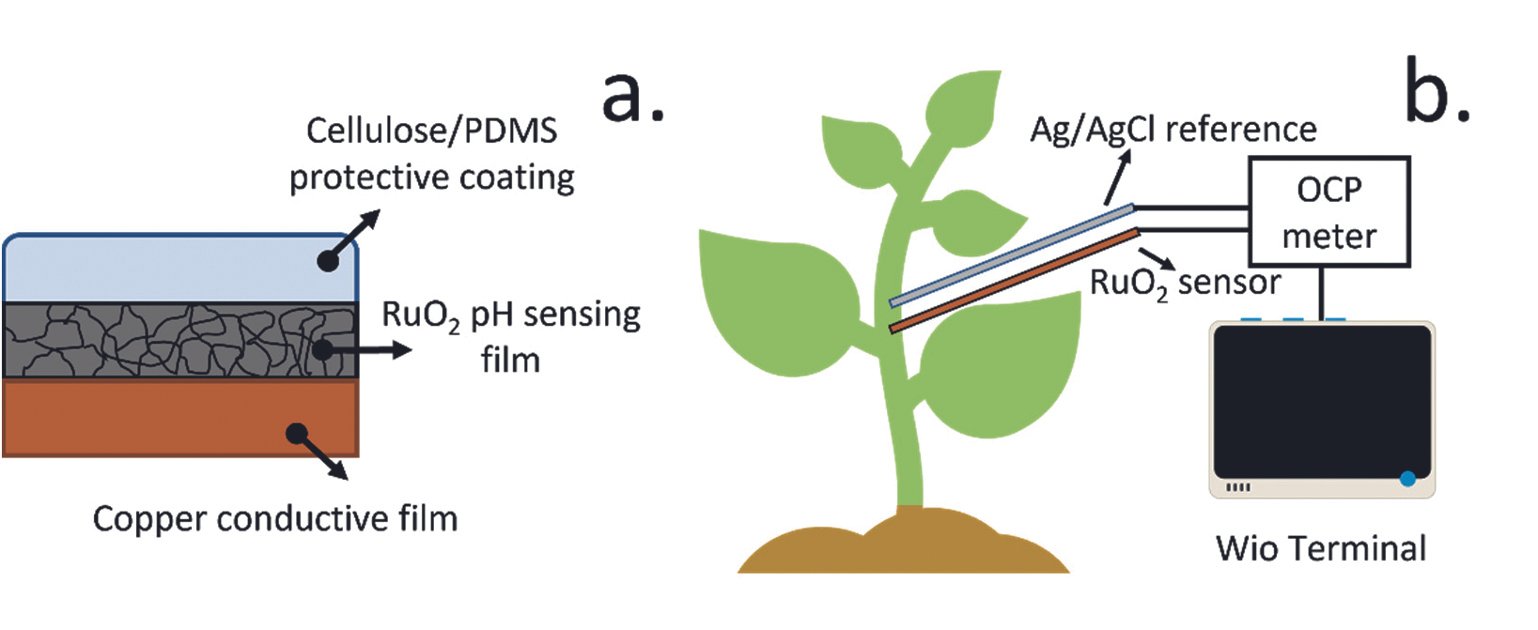
Stories from the University of Cambridge
In vivo sensing of pH in tomato plants using a low-cost and open source
device for precision agriculture
-
Antonio Ruiz-Gonzales, Harriet Kempson, Jim Haseloff
Department of Plant Sciences, University of Cambridge, Cambridge, UK
-
2021
-
Antonio Ruiz-Gonzalez:
a.gonzalez.16@alumni.ucl.ac.ukHarriet Kempson:
hljk2@cantab.ac.ukJim Haseloff:
jh295@cam.ac.uk -
Ruiz-Gonzalez A, Kempson H, Haseloff J. 2022. In vivo sensing of pH in tomato plants using a low-cost and open source device for precision agriculture. Biosensors 12, 447.
-
https://www.hackster.io/antonio-ruiz
-
Natural Environment Research Council – National Science Foundation (UK-USA)
ABOUT THE OPEN-RESOURCE
Background
Precision agriculture can provide farmers with valuable information on a range of aspects of their crops, such as nutrient levels, presence of pests and diseases, and abiotic stress. This data allows them to apply appropriate management strategies, helping to enhance crop yield. Although in the past few years remote sensing technologies have been advancing and becoming widespread, current methods for monitoring plant biomarkers directly are still very scarce. Thinking about the potential of these methods, Antonio Ruiz, Research Associate in the Haseloff Lab, at the Department of Plant Sciences, developed a low-cost electrochemical sensor to monitor pH of xylem sap in plants. “We focused on pH as it is quite a well reported biomarker, especially for abiotic stress. Sensors that measure moisture in soil are widely available, but it might not necessarily reflect on the plant status.
The plant might have the ability to endure a bit longer
in the soil that is dry, and you might be able to save some water, which is in high need in some places,”
said Antonio.
Function
It is an electrochemical sensor designed to monitor the pH in xylem sap continuously.
Development process
The first step in the sensor development was the material choice to ensure that the sensor could be used for long-term measurements and would be compatible with the plant organism. Antonio and his colleagues decided to deposit ruthenium oxide-based nanoparticles on top of the copper electrodes, as this material has been shown to be more stable and biocompatible than other options available. Also, the presence of ruthenium oxide is responsible for the H+ sensitivity, the ion measured to determine pH. When the first tests were performed with the sensor, the data generated had high noise rates, resulting in inaccuracies on the measured pH. To improve the stability and reduce the noise, the developers applied a cellulose-based coating to the electrodes. The final device was able to monitor pH in the xylem sap of tomato plants for at least 5 hours, with low noise.
Target user
Researchers and farmers aiming to assess plant abiotic stress in vivo directly.
Comparison to other technologies
Lab-bench pH meters with the reference probe suspended in a solution are common and well tested pieces of equipment. However, there are not many studies reporting devices to measure pH directly in the plant xylem. Antonio explains that most of the publications available use very destructive processes, extracting the sap, and then measuring the pH afterwards with a common pH meter. “We took the precision process of the sensors, which is normally done with benchmark equipment, to an easy setting that I managed to assemble at home, during lockdown. I don’t think it’s reported elsewhere of any other low-cost devices which are similar to ours,” explains Antonio. Another new aspect that this work has highlighted was the healing process that takes place between the sensor and the plant tissue, a response that is not well reported in the literature, and it is one of the major challenges in the field of implanted biosensors.
IMPACT
Current use
At the moment the device has been used only by the Haseloff Lab, but Antonio said that there have been a lot of comments and views on his hackster webpage (additional information can be found here), where the project was made openly available.
Open source choice
“Open source is the quickest way to make an impact in this field. From my point of view, you can see how people benefit a lot more when things are open and transparent to the community,” says Antonio. He points out the fact that the project has been published as a scientific paper and in hackster (a large hardware developer community) as it was very important to reach out to a broader audience. “We did get a lot of views from people that are not necessarily academics or researchers and you wouldn’t get that otherwise. You’d be surprised to see how immense the world of developers is outside the research paper.”
GOING FORWARD - WHERE TO IN THE NEXT 3-5 YEARS?
Antonio’s goal is to make the pH device more applied, trying to translate the fundamental science on sensors to an applied approach in precision agriculture.
Embodiment of the low-cost pH device © 2021, Antonio Ruiz, licensed under CC-BY 4.0. Reproduced from https://www.hackster.io/antonio-ruiz/a-low-cost-potentiostat-for-sensing-applications-41f863.
“Open source is the quickest way to make an impact in this field. From my point of view, you can see how people benefit a lot more when things are open and transparent to the community.”
Antonio Ruiz-Gonzales
(a) Schematic representation of sensor structure, and (b) its implantation inside a tomato plant. The open circuit potential was measured using a Wio terminal device (a microcontroller with Wi-Fi support). © 2022, Ruiz-Gonzales et al., licensed under CC-BY 4.0. Reproduced from Biosensors 12, 447, https://doi.org/10.3390/bios12070447?.



